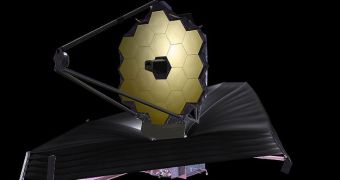The James Webb Space Telescope (JWST) will undoubtedly be the most advanced orbit-based observatory in the world when it will launch. Featuring an innovative design, and planned to operate from the L2 Lagrangian orbital point, the machine will scout the skies in infrared wavelengths. It was designed specifically as a replacement for the aging Hubble Space Telescope, which received its last, nearly full overhaul in May. One of the most advanced instruments for space exploration that will fly on the JWST is the Mid-Infrared Instrument detector, or MIRI. It is widely believed that this device will be capable of changing the way we look at the Universe, PhysOrg reports.
“The MIRI is one of four science instruments aboard the Webb telescope that is designed to record images and spectra at the longest wavelengths that the Webb telescope can observe. The mid-infrared spectrum covers wavelengths in the range of 5 to 28 micrometers or microns (about 10 to 50 times longer than our eyes can see). Light in this portion of the spectrum is invisible to our eyes but is produced by all room-temperature objects and carries key information about the local and early Universe,” the JWST Science Instrument Payload project scientist, Matt Greenhouse, explains.
He adds that these wavelengths are invisible for infrared telescopes based on the surface of the planet, because water vapors in our planet's atmosphere block such infrared radiation. Therefore, it is absolutely essential that an orbit-based, infrared telescope be used. In order to facilitate observations even further, the new observatory will be put on the L2 orbital point, where it will always remain in the same relative position in regards to the Earth-Sun-Moon system. It will be located at a distance of about 1.5 million kilometers from our planet, and will be facing away from us.
The JWST will also employ a light shield, which it will use to block stray light radiation coming in from the aforementioned system. It will also be cooled, nearly to absolute zero, as this will allow it to look very deep into the beginning of the Universe. Experts estimate that the sheer size of the new telescope – the largest one ever built – will enable MIRI to conduct exquisite science. It is believed that, once completed, the instrument will be up to 100 times more sensitive to these specific infrared wavelengths than any other similar device ever built.

 14 DAY TRIAL //
14 DAY TRIAL //